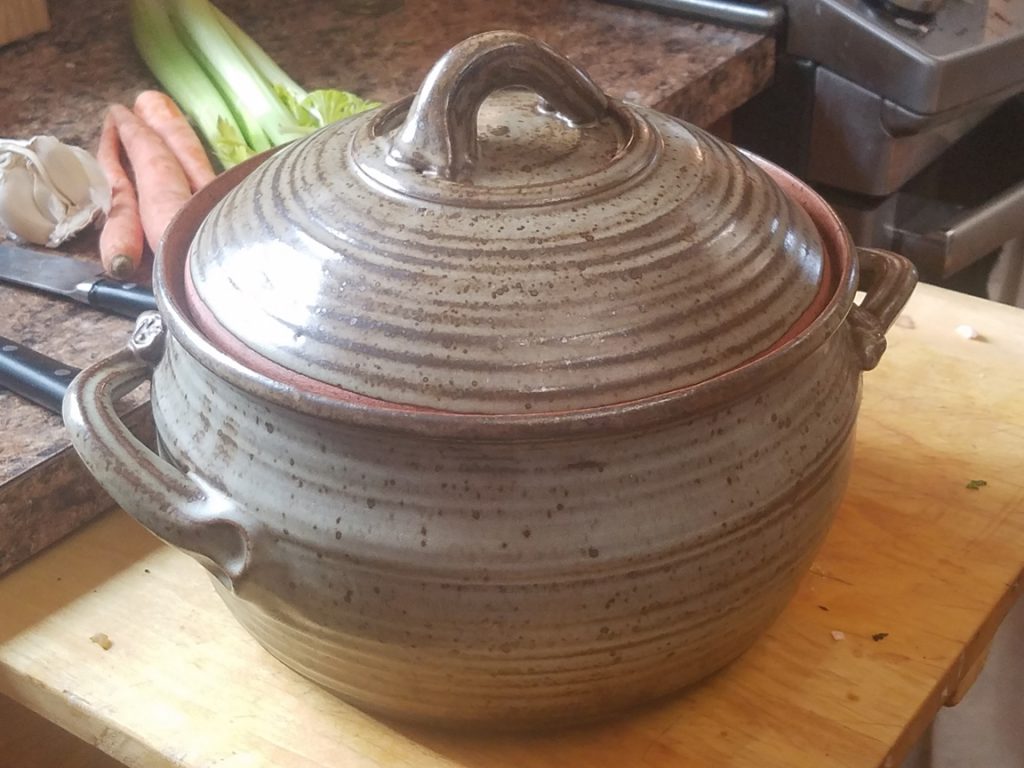Now there is a new way to cook with clay pots, Flameware All Ceramic Stovetop Cookware. This is not ceramic coated steel, cast iron or aluminum. It is all ceramic, hand made, solid ceramic cookware for the stovetop.
Generally, there are 3 types of cookware, you’re likely to run into, each with different methods. First, stoneware pottery (bowls, casseroles, baking dishes, plates, etc.) will crack if exposed to a direct flame. They need to be heated gently and surrounded by heat as in an oven.
Lower-fired earthenware pots made with earthen-ware clays, naturally formed with micaceous material, will also take a gentle flame without cracking. The difference is that the earthenware cooking pots are fired to about 1800 degF and do not vitrify (fuse) to be impervious to water. It remains somewhat like a clay flower pot. Indeed, ware such as Romertopf use that property to advantage.
Today, there are quite a few potters, or interested people, hand-making earthenware cooking utensils. The clay itself is now available through New Mexico clay in Albuquerque. Also, much of the cookware from Mexico and Europe, is of this low-fire type micaceous clay. Typically it is unglazed, or glazed only on the inside. Sometimes covered with a thin layer of wet clay that has color. They are often finished with by burnishing with a smooth rock or other tool, which can give them a shiny surface,.
THE DAWN OF FLAMEWARE
FLAMEWARE is the newer, easier way to cook with clay pots on a stovetop or other direct flame. Because these pots are all clay and fired to very high temperatures, they are completely non-toxic, lead-free, easy to clean, extremely durable, non-scratch, and easy to cook with and use. There is no “seasoning” to do, no soaking, little need for oils, and they god directly from freezer or refrigerator to the stove.
In the late 1970’s, William Crandall, at Alfred University in NY, developed a formula for a stoneware (high-fire) based flameproof clay pottery that would withstand direct flame which became known as Flameware. He patented [TW1] this in 1980 along with glaze recipes but the recipe and process are no longer patented. It was shown to potters at workshops during the 1980’s by famous potter Karen Karnes. Today, I know of only a few potters making stoneware FlameWare because of the demands of the clay and process. Also, because of demands for purity, the clay is some 4 times the cost of normal clay mixes.
STRONGER, EASIER TO CLEAN
Making FlameWare from stoneware clays means they are fired to nearly 2400 degF (cone 10) and become vitrified (glass-like). The fired clay has very close to zero expansion when heated so it will accept any heat you can throw at it.
My method of testing, besides regular use, was to freeze the test pot to 0 degF overnight, put it on a high gas flame until the surface measured 600 degF, and then plunge the hot pot in an ice-water bath.
Flameware is Non-Stick
Flameware is also much less fragile and doesn’t absorb oils and flavors from foods. This absorption in earthenware is not necessarily a bad thing as many cooks want that carry-over of flavors from previous use. It’s one of the reasons the traditional earthenware pots are so popular. (See Paula Wolfert’s book “Mediterranean Clay Pot Cooking”, one of the best discussions on different clay pots, instructions, and recipes for using them.)
The FlameWare pottery is also easier to clean, having a glass-like surface that is easy to scrub up if anything sticks (it generally doesn’t) with a green plastic scrubby or even metal (Brillo) pad.
I became aware of the stoneware FlameWare option after talking with Paula Wolfert about the Claypot. She asked if I could do earthenware clay cooking pots. I researched it and, at the time, the necessary micaceous clays were only available in the U.S. on Native American Sacred lands in the SW. She then led me to Bill Sax (now retired) in Massachusetts who had made stoneware flameware for some 30 years. I also knew of Terry Silverman of The Pottery Works in Fitzwilliam, New Hampshire who had been making flameware for some time (and still does). Also I know of Hoyt Corbett in Oregon who is a friend of Bill Sax.
Testing Flameware
At the time, I was at Clay Coyote Pottery near Hutchinson, MN, and we undertook developing a line of highfire stovetop cookware. It took us nearly 2 years to get to cookware that was dependable, develop a proper glaze we liked and test our wares. It finally worked. Success was a combination of proper clay, glaze, throwing technique and purity (non-contamination from other clays) of clay. I have since made and used, almost daily, Flameware pots I have made. I guarantee your satisfaction, and the pot’s performance, unconditionally with any pot I make.
Today, I still test several pots from each batch of clay. This involves putting the pot in the freezer overnight to be sure it’s at O degF. Then I immediately put the frozen empty pot on a flame burner turned to high.
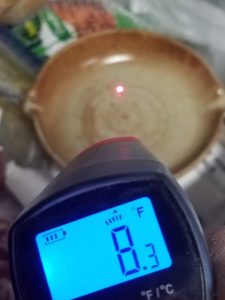
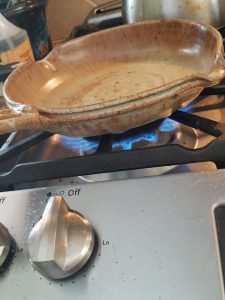
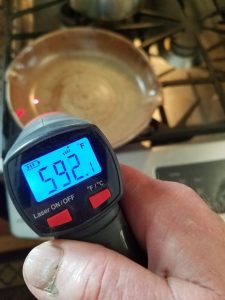
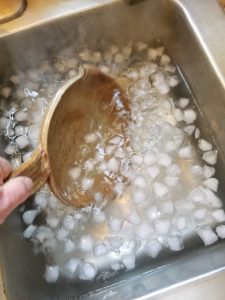
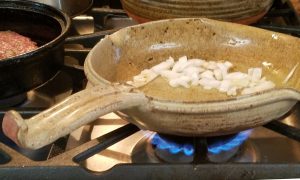
When it reaches between 500 to 600 degrees, I plunge it into an ice water bath, entering about 1/2 way for a couple of seconds, and then to full submersion. This stresses the pot more than any thing you will ever do at home.

